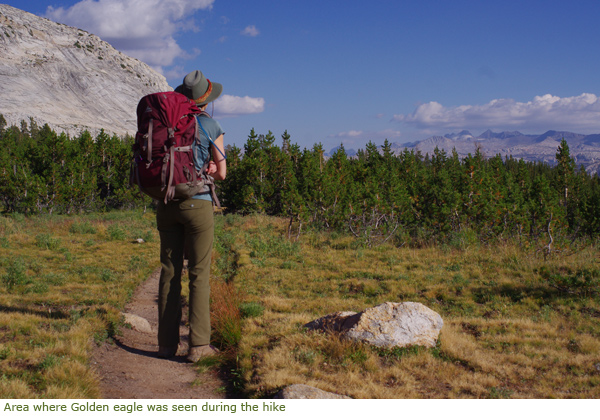Moisture isn't the only thing scarce at 10,000 feet elevation. My hiking partner waited patiently as I stopped for the umpteenth time to catch my breath. (I'd become soft, living and working at the 4,000 foot elevation of Yosemite Valley.)

I was beginning to contemplate whether the Belding's ground squirrels would take pity and consume me if I laid down on the trail, when the landscape expanded around us. Before us loomed a ragged granite peak, behind us the distant silhouette of the Cathedral Range, but at our feet in every direction sprawled a rolling meadow. Boulders and rocks of every size dotted the meadow like the scattered crumbs of a giant's lunch. As I scanned the landscape I noticed heads peeking from behind some of the rocks. Ground squirrels! They had come for me! Though these were not the brazen ground squirrels I had witnessed climbing visitors' legs at Degnan's Deli; they retained their natural, healthy fear of humans. Only those squirrels far off in the meadow were brave enough to perch atop rocks, supported on hind legs, to investigate the intruders. Just as we began to grow accustomed to each other's presence, an alarm call! The ground squirrels raced to their burrows. Something was wrong!
Instinctively I looked up, and what I saw took my breath away. Soaring just over our heads was an eagle! The powerful raptor was low enough we could see the yellow of its feet, the chocolate brown of its body, and the distinct "fingers" of the primaries (outermost flight feathers). I had seen this bird only once before in my life. It was a golden eagle!
We watched it soar for quite some time; as we watched it land on a far-off rocky outcropping, I contemplated the journey of this particular bird. Was it a resident of this beautiful meadow? Had it traveled from afar? Though most golden eagles in California stay in the state year-long, many move down-slope to the lower elevations for the winter. Some even come from other areas, migrating into the state to overwinter.

Each year hundreds of thousands of hawks, eagles, and vultures make their journey from Canada and the United States to wintering areas as far south as South America. Over the course of our backpacking trip we spotted four more distinct species of raptors, most likely recharging from the exhaustion of their long journeys. Some species of birds of prey, like the Swainson's hawk will travel more than 12,000 miles roundtrip from North America to Argentina.
Raptor migration can last from early August well into December with peak numbers in North America occurring around late September. Favorite spots to see these majestic birds occur in migration flyways spanning the country. These flyways are essentially bird interstates, running north and south over the width of the US. These travel corridors are often along mountain chains, much like the Sierra Nevada which I struggled to summit.
We all encounter struggles in our day to day lives, from the trivial to the transformative. But wherever you are this time of year, if ever it feels like your journey has become too arduous, just look up. And chances are good you might see a feathered source of inspiration to lift your spirits.
